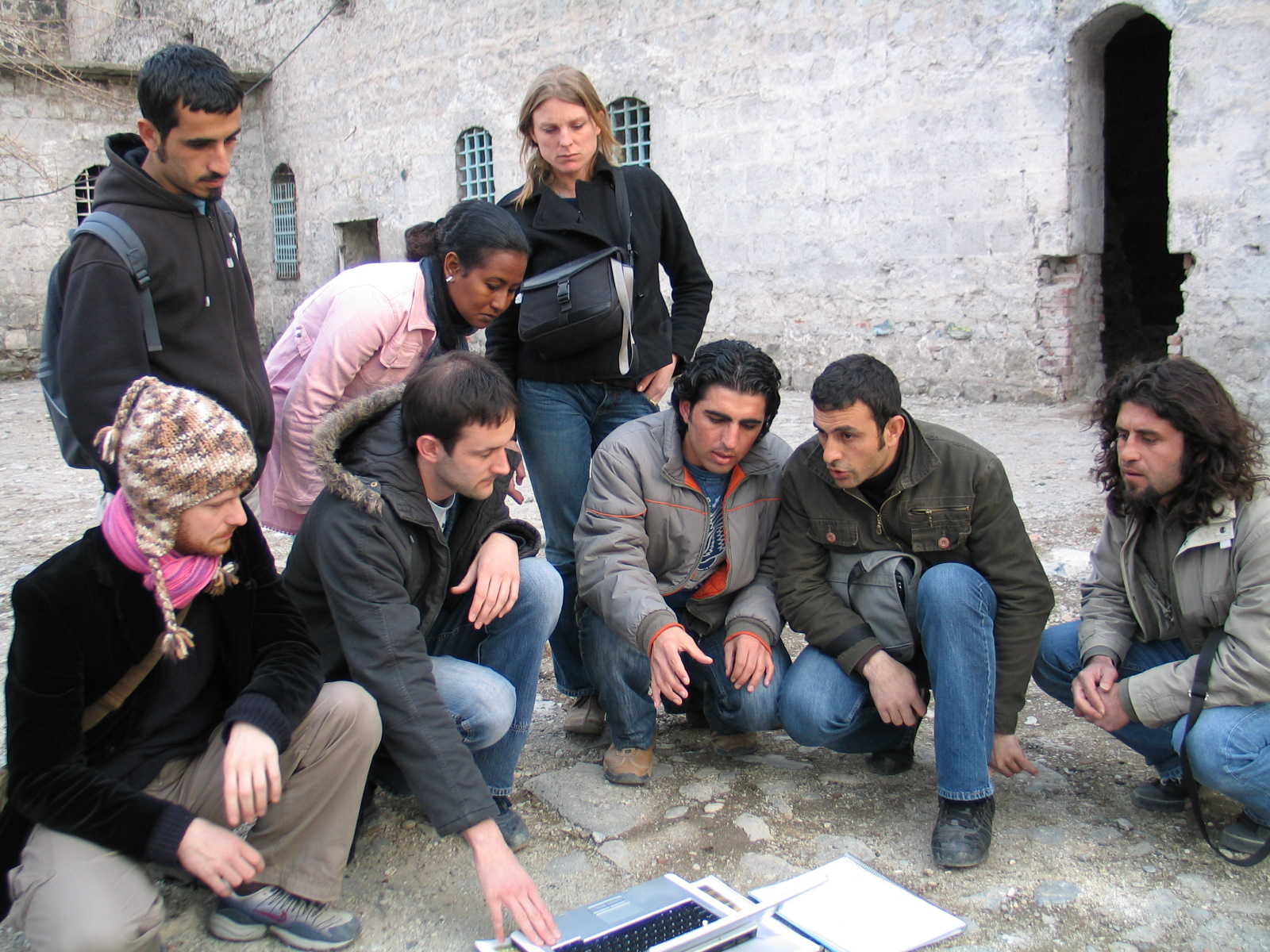2007, March 13 till March 23 ~ Diyarbakir ~ Here as the Centre of the World.
Seventeen artists from Europe (NL, UK, AU) Lebanon, Syria, Taiwan and Sudan collaborated in a common project around the old part of the center of Diyarbakir now named Suriçi (meaning "within the wall") which had been occupied by the Turkish army and special army units for many years. After the army left, the pro-Kurdish municipality renovated Suriçi, a lively and crowded quarter. But beyond the main streets many of those who became displaced in the vicious army campaign of the 1990s live a hard life in ramshackle houses.
Here as the Centre of the World was a transnational artistic research project, initiated and organised by the DAI, that took place in Damascus, Taipei, Diyarbakir, Khartoum, Beirut and Enschede in 2006 and 2007. The project consisted primarily of a series of ten-day workshops in each city, in which one street became the site and subject of research. Artists from each of the six locations worked collaboratively in small groups, carrying out an open-ended process of visual research and creating site-specific projects and short interventions in public space. This research process was supported by a series of lectures, debates, artists’ talks and round-table discussions in each city that opened up local artistic, cultural and socio-political discourses.
Each artist participated in workshops in their country of residence as well as at least one of the other five locations, creating a situation in which the relational nature of difference could be experienced. The workshops were an invitation for artists to ‘de-centre’ their practices – both to engage with a new ‘centre’ and to look differently at their usual artistic context, considering how one’s perception and conception of art is culturally and socially informed and reflecting on the real conditions in which cultural differences are articulated in the day-to day activities of artists and art workers. Operating in the contact zone between cultures, the project raised issues surrounding the translatability of art. By making space for competing artistic paradigms, it problematized the notion that contemporary art has an international language shared by artists worldwide.
Curators Here as the Centre of the World: Lucy Cotter, Gabriëlle Schleijpen, Alite Thiisen *
Artistic leaders in Diyarbakir: Erkan Özgen, Libia Castro & Ólafur Ólafson and Lucy Cotter.
*
Projectmanager Diyarbakir: Rik Fernhout
Partners: Anadolukultur & Diyarbakir Art Center
* Participants: Machteld Aardse (NL), Barýþ Seyitvan (Diyarbakir), Chris Meighan (UK), Mei-yu Tao (Taiwan), Omima Hasab El Rasoul (Sudan), Mýzgin Deniz (Diyarbakir), Mehmet Polat (Diyarbakir), Seckin Aydin (Diyarbakir)and others.
ABOUT DIYARBAKIR
* name spelled in local alphabet/dialect
-Diyâr-ı Bekr; Kurdish Amed / Amida)
* capital or not / if yes of what country
-No official capital, though also known as the unofficial capital of Kurdistan
* some important data :
-Diyarbakır is the largest city in Southeast Turkey.
-The history of Diyarbakır counts 5.000 years, in which 26 different civilizations have inhabited the city.
-The city is surrounded by an intact set of high walls of black basalt forming a 5.5 km circle around the old city, and was built between 300-1600 AD. Within the fortification, the houses in the old neighbourhood are constructed of basalt stone.
-After the establishment of the Turkish Republic in 1923, Diyarbakır became the object of Turkish-nationalist policies against Kurds, as a result of which Kurdish elites were destroyed and many Kurds deported to western Turkey. Since then, hostilities and clashes have occured between the PKK (Kurdistan Workers' Party) and the Turkish army.
-During recent conflict, the population of the city grew dramatically as villagers from remote areas entered the city for the relative security. Diyarbakır grew from 30,000 in the 1930s to 1.5 million by 1997.
-According to a survey by the Sur Municipality, one of Diyarbakır's metropolitan municipalities, 72% of the inhabitants use Kurdish the most in their daily speech, while Turkish is the official language.
*region :
-South East Anatolia
*province:
-Diyarbakır
* elevation:
-675 m
*main river or sea:
-Tigris
* climate:
-Continental; hot, dry summers, harsh cold winters
* main economical activity:
-Agriculture, textile
* population (number):
-600.000 (2007 est)
* etnicities:
-Kurdish, Turkish
* religions:
-Muslim 99.8% (mostly Sunni), other 0.2% (mostly Christians and Jews)
* language(s):
-Kurdish, Turkish
* average income:
-$ 5,02 per capita (2007)
* political situation in two sentences:
-While the past few years have seen an upsurge in rebel attacks between the Turkish army and the PKK, the situation in Diyarbakır is now relatively stable, partly due to a greater degree of official tolerance for Kurdish cultural activities, encouraged by the European Union. Until today, the Kurdish minority, of whom a greater part lives in Diyarbakır, states that the Turkish government has tried to destroy their Kurdish identity and that they suffer economic disadvantage and human rights violations.
* places of interest(sites):
-The City Wall, Archaeology Museum, Behram Paşa Camii (Mosque), Ulu Camii (the Grand Mosque), Cahit Sıtkı Tarancı Museum
* favourite sport:
-Football
* local dishes:
-Dishes of lamb, Döner kebab
* famous films/books in which the city figures:
-Films: La espalda del mundo, 2000, Javier Corcuera, Yol, 1989, Serif Gören
-Books: Orhan Pamuk, Snow, 2002
* famous inhabitants:
-Kawa Nemir, Ahmet Kan
* museums and art-institutes or organisations:
-Anadolu Kultur, Diyarbakir Art Center
*artschools:
-University of Fine Arts, Diyarbakir

